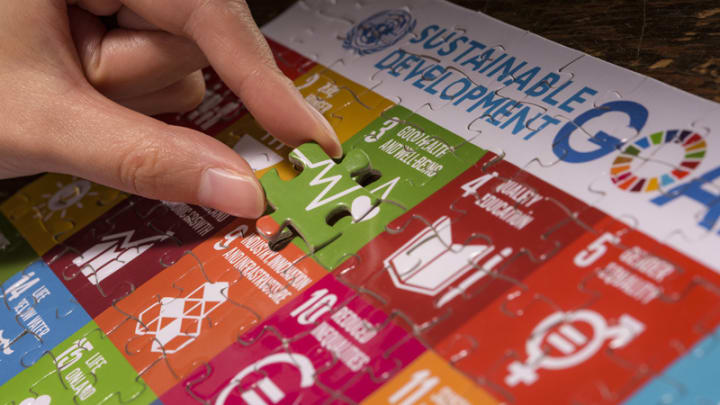Done some homework?

At the heart of the 2030 Agenda for Sustainable Development, adopted by all United Nations member states in 2015 is the 17 Sustainable Development Goals (SDGs) which are an urgent call for action by all countries in a global partnership. Sustainable development is a development that meets the present, without compromising the ability of future generations to meet their own needs. The development is based on three main pillars, namely society, economy, and nature. What progress, specifically in the environment sector has been made by Mongolia in the last three years regarding SDGs? Are we successfully doing our homework?
Of the 17 SDGs, six goals have a direct connection with environment and tourism sectors. Namely, these include access to clean water and sanitation, air quality, sustainable tourism, waste management, climate change and protection of terrestrial ecosystems. Each goal has a list of targets which are measured in indicators.
United Nations Economic Commission for Europe, in its Environmental Performance Review, praised Mongolia for being one of the leading performers in terms of establishing SDGs related policy documents and institutional mechanisms yet criticized its slow compliance and implementation of these legislations. Reduction of CFC, takhi reintroduction and active participation of residents in natural resource management have been noted as main achievements while the expansion of mining activities and air pollution are the main drawbacks for Mongolia. Implementation of SDGs is on par with the level of southeast countries though half of the 17 goals have been classified as red or difficult to attain. In 2019, Mongolia submitted its Voluntary National Review which showed what steps the country has taken to implement the SDGs and targets and provided an assessment of the results to the UN. The review, it specified that Mongolia has made significant progress in the environmental sector to meet obligation it held to the United Nations Framework Convention on Climate Change (UNFCCC).
Current projects in the environment and tourism sector within the framework of SDGs
SDG 6: Most of Mongolia’s water resource is formed in 30 percent of its territory and the remaining 70 percent is at risk from water scarcity. The Ministry of Nature and Tourism is responsible for determining and verifying water resources in Mongolia. “Every country other than Mongolia imposes a fee for the use of water resources and, we are planning to establish payment system according to gradual increase principle,” says T.Bulgan, director of Green development policy and planning department of the ministry. In UB, apartment residents use 110L per day, while according to the World Health Organization estimation, the minimum required water usage per person is 10 l per day. The introduction of the payment system will certainly instill a water-saving culture to residents, it is believed.

SDG 8: Within the Goal 8 targets implementation, ecotourism should be promoted. The core concept of the promotion is: instead of building asphalt roads, more attention would be paid to support environmentally friendly tourism such as hiking and trekking. We must not forget eco-tourism is based on responsible travelers. Hence, to support responsible tourism, temporary camps and sanitation facilities would be set up along the main travel routes, including Tuluugiin Davaa and Elsen Tasarkhai.

SDG 11: There is an urgent need for business entities to introduce smart solutions and ensure close cooperation to support waste-free production. By establishing a system where wastewater reuse practice is supported, the waste-free economy would be sustained. These water reuse practices may include irrigation of gardens, agricultural fields or indirect potable use. The Ministry has proposed to international organizations to make preliminary analysis on the use of reclaimed water from MCS Coca-Cola LLC at Amgalan thermal power station.

SDG 12: Waste disposal is a very costly process. At present, Mongolia is making an effort to adopt legal arrangements such as the polluter-pays principle. Besides, Law on Eco payment which imposes additional payments to the producers and importers of all kinds of plastics, used car accumulators, tires, batteries, glass, and toxic chemicals have been drafted. The law will ensure increased responsibility for producers and importers and, additional payments would enae the government to invest in sustainable management tasks, such as waste recycling. The land permits for the hazardous waste disposal centers to be built in Baganuur and Songino Khairkhan districts have been issued.

SDG 13: Importers and producers in construction, transportation and agriculture sectors which are primary resources of greenhouse gas emissions would be under pressure to increase their awareness and responsibility. Several international financing resources support activities aimed to reduce greenhouse gas emissions and one of them is Green Climate Fund which has approved 7 projects in Mongolia. The largest one is Ulaanbaatar Green Affordable Housing and Resilient Urban renewal project, co-financed by the Asian Development Bank.

SDG 15: Taking areas under the special protection of the state is one major method to support the ecosystem and its services and prevent land degradation and desertification. About 48 percent of the area of the headwaters of rivers is under special protection whereas the size of specially protected areas accounts for 20.1 percent of Mongolia’s territory. In 2019, 22 areas have been given special protected area status which increased the number of specially protected areas to 115 and their size to 31.4 million hectares land. Shortly, a total of 9 areas would be taken under the special protection of the state.
